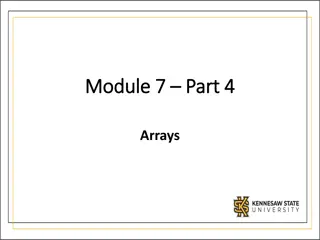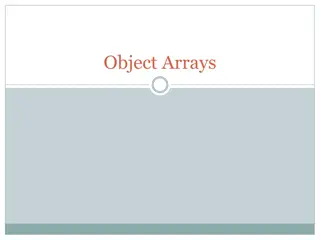Understanding Solar PV Components: Cells, Modules, and Arrays
Solar PV components such as cells, modules, and arrays play a crucial role in converting sunlight into electricity. This unit covers basic terms related to solar PV components, including solar cells, P/N junctions, cell output, various cell constructions, and cell wiring configurations. Explore the world of semiconductors, solar cell technology, and the junctions that create modern solar cells. Gain insights into the materials and processes involved in harnessing solar energy effectively.
Download Presentation

Please find below an Image/Link to download the presentation.
The content on the website is provided AS IS for your information and personal use only. It may not be sold, licensed, or shared on other websites without obtaining consent from the author. Download presentation by click this link. If you encounter any issues during the download, it is possible that the publisher has removed the file from their server.
E N D
Presentation Transcript
Components CELLS, MODULES AND ARRAYS Except where otherwise noted these materials are licensed Creative Commons Attribution 4.0 (CC BY)
The objective of this unit is to present the student with some basic terms relating to solar PV components. Upon completion, the student will have an understanding of the following: Solar cells P/N junction Cell output Various cell construction Cell wiring configurations Objectives Cells, Modules and Arrays
Cells, Modules and arrays Rfassbind [Public domain]. Retrieved from https://commons.wikimedia.org/wiki/File:From_a_solar_cell_to_a_PV_system.svg
Solar cells are semiconductor devices that convert sunlight to DC electricity. A solar cell is the basic element of a PV module. Solar cells are roughly the thickness of a piece of paper .1 mm or 100 micrometers. They are made out of the same semiconductor as computer chips. Solar Cell Gil Knier [Public domain]. Retrieved from https://commons.wikimedia.org/wiki/File:Operation_of_a_basic_photovoltaic_cell.gif Cells, Modules and Arrays
A semiconductor is a material that consists of the electrical conductivity characteristics between that of a conductor and insulator. Semiconductors are generally made from silicon or germanium, though silicon is by far the most common element used in semiconductors today. Silicon makes up 90% of the Earth s crust, making it the second-most available element in the Earth s crust. Semiconductor MichelBakni [CC BY-SA 4.0]. Retrieved from https://commons.wikimedia.org/wiki/File:Silicon_doping_-_Type_P.svg Cells, Modules and Arrays
A solar cell converts solar radiation to DC electricity and is the basic building block of PV modules and arrays. Modern solar cells are created by junctions between different semiconductor materials. A typical crystalline silicon solar cell is a junction between boron- doped silicon (P-type) and phosphorus-doped silicon (N-type) semiconductors. P- Type and N type Doped silicon N-type semiconductors are materials having excess electron charge carriers. P-type semiconductors are materials having a deficiency of electron charge carriers or excess electron voids (holes). Image by MIT OpenCourseWare [CC BY 2.0]. Retrieved from https://www.flickr.co m/photos/mitopencou rseware/3363321260 Cells, Modules and Arrays
The interface where P-type silicon and N-type silicon meet is called the P-N junction. It is also known as the depletion region. At the P-N junction, the electrons fill the holes right next to them and form a gate or block of sorts. P-N Junction Bhpaak [CC BY-SA 4.0]. Retrieved from https://commons.wikimedia.org/wiki/File:Standard_Solar_Cell.png Cells, Modules and Arrays
The photovoltaic effect is the process of creating a voltage across charged materials that are exposed to electromagnetic radiation. Photons from the sun contact the cell and its P-N junction, causing a state imbalance by moving charged particle across the junction. By adding a conductive circuit and a load to the outside of the cell, it gives the electrons a path for flow to the other side as a means of finding balance. The Photovoltaic Effect This is a constant process as long as the sun is shining on the cell. Cyferz at English Wikipedia [CC BY 3.0]. Retrieved from https://commons.wikimedia.org/wiki/File:Silicon_Solar_cell_structure_and_mechanism.svg Cells, Modules and Arrays
After all the solar cells are soldered together in a series, they are placed between two layers of encapsulant also known as EVA (ethylene vinyl acetate). The front glass must be very low or no iron and must be tempered. A tough polymer back sheet will protect the back of the cells. PV Module Construction Qmwnebvr97 [CC BY 4.0]. Retrieved from https://en.wikipedia.org/wiki/File:Layers_of_solar_panel.jpg Cells, Modules and Arrays
Adding modules in series, just like with cells, will increase voltage. VOC or voltage open circuit : When voltage is measured with no load and an open positive and negative. + VTOTAL = 24 V - ITOTAL = 6 AMP Design for 24 Volt 12 volt 6 Amp Modules Northeast Iowa Community College [CC BY 4.0]. Cells, Modules and Arrays
Design for 48 Volt DC + VTOTAL = 48 V - ITOTAL = 6 AMP 12 volt 6 Amp Modules 48V 6 Amp Northeast Iowa Community College [CC BY 4.0].
When two or more modules are connected in series together to reach a certain voltage for a device, this is known as a string. When a measurement of voltage is taken at the ends of an open circuit for a string, it is still called VOC (voltage open circuit). String State of New York [Public domain]. Retrieved from https://www.nyserda.ny.gov/All-Programs/Programs/NY-Sun/Communities-and-Local-Governments/Solar-Guidebook-for-Local- Governments Cells, Modules and Arrays
Parallel is when the positives leads of modules are tied together and all the negatives leads of modules tied together. This does not do anything to Voltage but will increase Amps or the current. + VTOTAL = 12 V - ITOTAL = 12 AMP Design for 12 Volt 12 Volt 6 Amp Modules Northeast Iowa Community College [CC BY 4.0]. Cells, Modules and Arrays
An Array: Modules are connected in series to reach a certain Voltage. Then those strings are connected in parallel to reach a certain amperage. This will create an ARRAY of how many Watts? (Volts x AMPS = Watts) + VTOTAL = 48 VDC - ITOTAL = 20 AMP 10 Amp Modules Array 12 volt Cells, Modules and Arrays Northeast Iowa Community College [CC BY 4.0].
Upon completion of this unit, students should be able to Discuss how cells modules and arrays differ Explain the P & N junction Discuss the PV effect Compare different cells Explain the different configurations Explain how to hook-up cells for different outputs Conclusion This presentation was prepared by Northeast Iowa Community College under award EG-17-004 from the Iowa Energy Center. Any opinions, findings, and conclusions or recommendations expressed in this material are those of the author(s) and do not necessarily reflect the views of the Iowa Energy Center. Cells, Modules and Arrays























